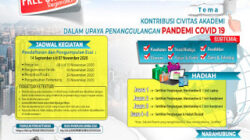Sepenggal info – Certain guidelines need to be followed before writing a research paper or ascertaining the fundamental question for research. M S Sridhar offers an insight into the process of formulating and selecting a research problem
There is no short cut to research. One has to go through every phase of it in detail. Often, student-researchers hastily skip the stage of choosing and formulating a research problem by borrowing or imitating a title which is wrongly presumed to be a research problem and then face difficulties later. Here are some tips to select and formulate a research problem.
*A research problem cannot be borrowed; a researcher has to find his own problem; a guide can only help in choosing a broad subject or topic
*Right questions must be addressed; having a topic to read about is different from having a problem to solve; a topic to read leads to aimless and endless gathering of data and there is no way of ascertaining when we have enough to start. Further, this can also lead to a struggle to decide what to incorporate in the report
*Have an unbiased and unattached approach; No matter how complex it is, be objective
*Be uncommitted before selection
*Have more than one problem to ponder over, i.e., keep alternatives
*Never settle on a particular approach at the first instance; the decision on methodology should not precede problem selection
*Interact with experts and practitioners
*Avoid superficial and obvious problems as well as overdone and controversial subjects
*Avoid too narrow or too vague problems (settling on a broad topic with four or five words is risky.)
*Have a preliminary ‘quick and dirty’ study and / or a brief feasibility study
*Problems should suit your interest, competence and ability
*Identifying gaps through literature surveys throw up new problems
*Check the availability of the required data and co-operation of people concerned
*The problem should be novel, significant and useful to practitioners; the utility of the expected findings should be judged
*Spend a lot of time writing and note taking to understand the problem
*Make preliminary outlines, disagree with what is read, draw diagrams to connect disparate/ disconnected facts, summarise sources, record random thoughts, which can be discarded later if necessary. Start writing at the very beginning in order to encourage critical thinking, to understand sources better and to draft more effectively.
Some important sources for research problems include reading, academic/ or other daily work experience, exposure to field situations, consultations, brainstorming, past research and intuition. Discussing how to select and define a project, Catherine Dawson in Practical Research Methods (2002) summarises the questions to be raised and answered by a research student.
*Why have I decided to do some research?
*What personal characteristics do I have which might help me to complete my research?
*What skills and experience do I have which might help me in my research?
*The five ‘Ws’: What is my research?; Why do I want to do this research?; Who are my research participants?; Where am I going to do the research?; When am I going to do the research?
*You must take time to think about your research as this will save you problems later.
*When you’re thinking about your research, keep asking yourself questions
*Sum up your research project in one sentence
Source : http://www.deccanherald.com/content/295022/selection-formulation-research-problem.html








